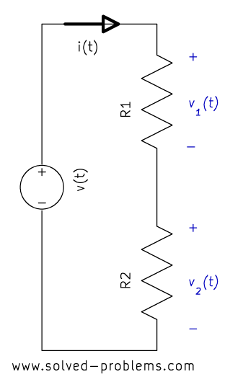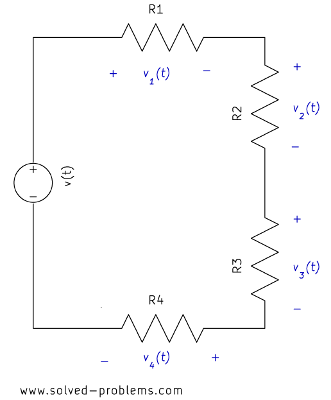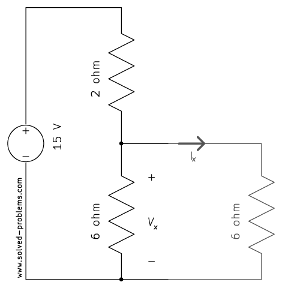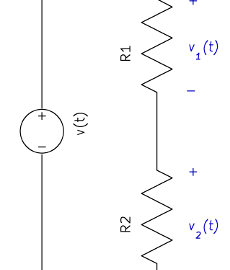The voltage division rule (voltage divider) is a simple rule which can be used in solving circuits to simplify the solution. Applying the voltage division rule can also solve simple circuits thoroughly. The statement of the rule is simple:
Voltage Division Rule: The voltage is divided between two series resistors in direct proportion to their resistance.
It is easy to prove this. In the following circuit

the Ohm’s law implies that
![]() (I)
(I)
![]() (II)
(II)
Applying KVL
![]() .
.
Therefore
![]() .
.
Hence
![]() .
.
Substituting in I and II
![]() ,
,
![]() .
.
Consequently
,
.
which shows that the voltage is divided between two series resistors in direct proportion to their resistance. The rule can be easily extended to circuits with more than two resistors. For example,

![]() ,
,
![]() ,
,
![]() ,
,
![]() .
.
The voltage division rule can be used solve simple circuits or to simplify solving complicated circuits.
For example, check out this problem.
One of the common mistakes in using the voltage division rule is to use the formula for resistors which are in parallel with other elements. For example, the voltage division rule cannot be used in the following circuit directly.

It will be incorrect if one tries to find ![]() using voltage divider by neglecting the other
using voltage divider by neglecting the other ![]() resistor as
resistor as

So, ![]() . However, if solving other parts of a circuits confirms that the current of the other element/branch is zero, the voltage division rule can be still applied. For example, suppose that the following network is a piece of a larger circuit.
. However, if solving other parts of a circuits confirms that the current of the other element/branch is zero, the voltage division rule can be still applied. For example, suppose that the following network is a piece of a larger circuit.

Let’s assume that the analysis of the circuit shows that ![]() . In this case,
. In this case, ![]() regardless of where A and B are connected.
regardless of where A and B are connected.
The voltage devision rule can be used to ease solving problems. For example, the voltage division rule is used in the following problem to find the Thévenin voltage:
Thévenin’s Theorem – Circuit with An Independent Source
.

a parallel plate capacitor has area=2 mm and plate separation distance, d=1 mm. find how much charge is stored when the capacitor si connected to a 10 volts battery.
C = epsilonr*epsilon0*A/d
Q=C*V
Work it out for yourself!
The charge is 1.77e-16 coulombs
Really usefull.Especially the voltage divider thing, I struggle with it in Polytechnic and Iam still struggling with it but thanks, I have cleared the confusion after going through your information.
really sooorry for last one. That is my younger brother’s deeds.valuable information. but you didnt mention any thing about parallel circuits.
Super
The voltage divider formulas and the solved problems are very useful to me. I corrected several circuits in our company. Thanks a lot for the support.
This is very helpful and easy to follow I can now complete my assignment
Thank uu so much
the questions are very challenging and concept oriented…hence keep it up!!!
Confused about the line ‘now substitute in I and II’ what exactly is substituted? I cannot see where this step came from.
THANKS…USEFUL INFO…
Hi Yaz,
You seem to have a good page, but the graphics have either fallen away over time or otherwise are not present.
Thanks for the math, though — it was useful review and simplified expression!
A big noisy THANK YOU
Hi
Good and simple to understand. hope to see simple calculation to solve complicated circuit which comprises voltage and current sources
Greg
hey,
really confused about the part where parallel circuits are given and voltage division rule cannot be applied directly. Isn’t voltage supposed to be equal across parallel resistances?